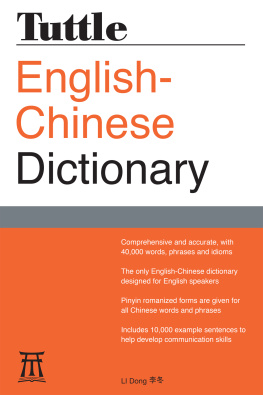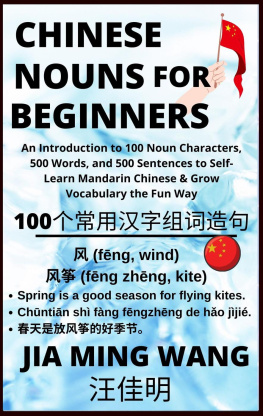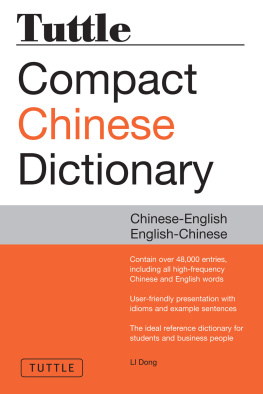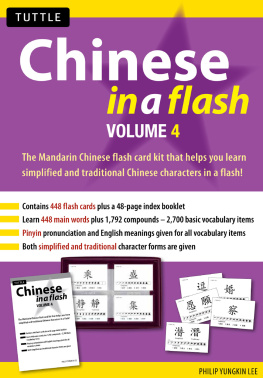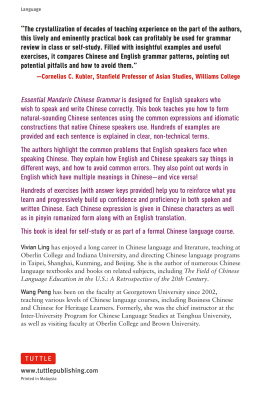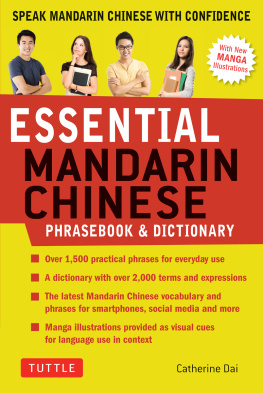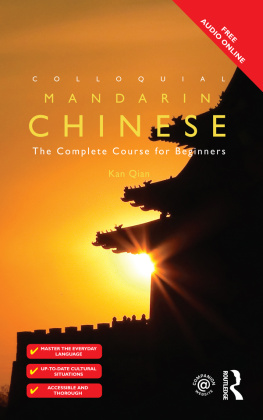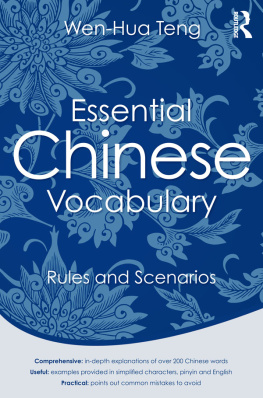Chinese for Everyday Scenarios Published by Yilian Feng at Smashwords Copyright 2014 Yilian Feng This ebook islicensed for your personal enjoyment only. This ebook may not bere-sold or given away to other people. If you would like to sharethis book with another person,please purchase an additional copy for each recipient. If yourereading this book and did not purchasing it, or it was notpurchased for your use only, then please return to your favoriteebook retailer and purchase your own copy. Thank you for respectingthe hard work of this author. "^t Foreword Welcome to Scenario Chinese! This book ismainly written for foreigners who come to Taiwan for work ortravel, as well as Chinese language teachers of foreign students.As students rapidly learn to build words into sentences, theyexperience the thrill of enjoyment and a sense of accomplishment.The book also allows Chinese teachers to give clear instructions onhow sentences can be structured.
Learning in a real-life context can make bothlearning and teaching more fun and effective. Instead of memorizingthe vocabulary mechanically, I recommend using role play topractice the vocabulary or phrases in everyday situations.Vocabulary, phrases and sentences derived from a context can givelearners a clearer picture of how they can be used in daily life.Acting out a dialogue based on a scenario can allow learners toacquire the knowledge of not only the meanings of the words butalso when to use them. When they encounter with the scenarios fromthis book in real life, they can easily retrieve them from theirpersonal pool of Chinese knowledge and use the appropriateexpressions. This book is divided into six chapterscovering socializing, eating, shopping, transportation, pastimes,and other services, which provide foreigners with Chinese for dailysurvival. It is recommended to start with the pages that describethe tones and pronunciation of the Chinese sounds. Then by scanningthe table of contents and appendices, you can choose to start fromany chapter according to your needs as each chapter is anindependent and a complete learning unit by itself.
Each chapter iswritten with the aim of building Chinese language skills from wordsto sentences based on different scenarios. I hope you enjoyembarking on this Chinese learning journey with Chinese forEveryday Scenarios! Table of Contents Pronunciation Guide Chinese is alanguage based on tones. Learning the tones is an important key tomastering Chinese pronunciation. There are mainly four tones in theChinese language, and one neutral tone (also called the fifthtone). The same word can have different meanings based on the tone.For example, the word ji has four different meanings based on thetone that is used. 2nd Tone: To pronouncethe 2nd tone, the pitch goes up gradually. 3rd Tone: To pronounce the 3rd tone, thepitch first goes down and then up. 4th Tone: To pronounce the 4th tone, thepitch is shorter and goes down quickly. 4th Tone: To pronounce the 4th tone, thepitch is shorter and goes down quickly.
Neutral Tone: Neutral tones are indicatedwithout a symbol. To pronounce the neutral tone, the pitchdrops very quickly and almost stops right away. The tones are represented by symbols abovethe vowels in the Pinyin (the Chinese word written with the Englishalphabet), to show how a word should be pronounced (e.g.,n ho m?w hn ho.) The Roman characters are mostly pronouncedthe same as the English alphabet. However, there are someexceptions, illustrated as below: vowels English similarity Pronunciation Tip a a in whatSame as English aii in hiSame as English aoow in howSame as English e a in aboutSame as English ei ay in haySame as English er er in laterSame as English i ea in seat; ea sound: same as English uin putwhen appears afterc,ch,r,s,sh,z,zh How to pronounceusound ? 1.The tip of your tongue touches the lowerteeth. 2.The mouth slightly opens. ian yen How to pronounce ian sound? 1.The tip of the tongue touches the lowerteeth. 2.Slightly open the mouth and graduallyflatten the mouth shape , allowing a little air to go through themouth. uo oa in float How to pronounce uo sound? 1.Round the lips like a small circle. 2.The tip of the tongue first touches theupper teeth and then slowly leaves it. yu/ How to pronounce yu/ sound? 1.Round yourlips like the shape of your mouth when whistling. 2.Touch the lower teeth with the tip of yourtongue 3.The air goes through your lips. 2.Touch the lower teeth with the tip of yourtongue 3.The air goes through your lips.
Consonants English similarity PronunciationTip c ts eg: hats How to pronounce c sound? 1. Try to bite the upper and lower teeth. 2. Put the tip of the tongue behind theclosed teeth. 3. h hu in hut How to pronounce h 1.Half open your mouth. 2.The air goes through your mouth. q ch + i How to pronounce 1.Bite the teeth tightly . 2.Use the tip of the tongue to touch thelower teeth. 3.As the air goes through the teeth, flattenyour mouth shape. r s in measure How to pronounce r sound? 1.Curl your tongue back. 2.The tip of your tongue touches your upperhard palate. sh sh in she How to pronounce sh sound? 1.Curl back your tongue. 2.Slightly open your mouth. 3.The air goes through your mouth. x Say alphabet c How to pronounce x sound? 1.Try to bite the upper and lower teeth andthen slightly separate it. 2.The tip of the tongue touches the lowerteeth. 3.The air goes through the slightly openmouth. z ds in bids How to pronounce z sound? 1.Bite the teeth tightly. 2.The tip of the tongue touches the lowerteeth. 3.The air goes through the closed teeth andcauses vibration. zh ju in just How to pronounce zhsound? 1. zh ju in just How to pronounce zhsound? 1.
Curl your tongue. 2.The tip of your tongue first touches theupper palate. 3.As the air goes through the mouth, the tipof tongue leaves the upper palate. *Some characters have more than onepronunciation for the same meaning. For example, in(what) can be pronounced assh or shn and (and) can be articulated as h or hn. Somecharacters written in different ways may have the samepronunciation and meaning.
For instance and both mean take a vacation, and bothmean spend time as well asand both mean the wind blows. Chapter One d y zhngSocializing sh jio Unit One dy k Making a Phone Call Scenario Background: Brian called Ann andasked her out for breakfast and while they were eating, theydiscussed having a birthday celebration for Joe. A.From Words to Sentences 1. jn tin jn tin today [ ] [] [jn tin] [sh] today is [ ] [] [] [] [] [] ? [jn tin] [sh] [ j ] [ yu ] [ j ] [ r ] [today] [ is] [Which] [month][Which][date] What is the date today? 2. sh yu [ ] [] [ sh ] [ yu ] October [] [] [] [ ] [ sh ] [ yu ] [ sh y ] [ r ] October 11th [ ] [] [] [] [] [] [jn tin] [ sh ] [ sh ] [ yu ] [ sh y ][ r ] Today is October11th. z o cn z o cn breakfast [ ] [ ] [ ch ] [ zo cn] have breakfast [ ] [] [] [ y q ] [ ch ] [zo cn ] [together] [ have] [breakfast] have breakfast together [ ] [ ] [] []? [ yo b yo ] [ y q ] [ ch [ zo cn] [Want or dont want to ] [together ] [have][breakfast]? [ ] [] [ ] [] []? [ n ] [ yo b yo][ y q ] [ ch ][ zo cn ] [you][ Want or dont want to] [ together ][have] [breakfast]? Do you want to have breakfast together ? 4 fn zhng fn zhng minutes [ ] [ ] [ sh w ] [ fnzhng ] fifteen minutes [ ] [ ] [] [ sh w ] [ fnzhng ] [ hu ] fifteen minutes later [ ] [ ] [] [] [ sh w ] [ fnzhng ] [ hu ] [ jin ] [fifteen] [minutes] [later] [see/meet] See you in 15 minutes. [ ] [] [] [] [] [] [ sh w ] [fnzhng] [hu] [zi] [yng h du jing][jin ] [fifteen] [minutes][later][in/at ][ Yong-HeSoybean Milk Shop][see/meet] Ill meet you at Yong-He Soybean Milk Shop in15 minutes. 5. mng tin mng tin tomorrow [ ] [ ] [ mng tin ] [ wnshng ] tomorrow evening [ ] [ ] [ ] [ mng tin ] [ wnshng ] [ li din ] [tomorrow][ evening] [six oclock] 6:00pm tomorrow [ ] []place [ yu ] [ zi ] [Make appointment and meet]place [ ] [] [] [] [] Brickyard [ mng tin ] [wnshng ] [ li din ] [ yu ] [ zi ] [tomorrow] [evening][ six oclock][ makeappointment and meet ][at] Brickyard Lets meet at 6:00 tomorrow evening atBrickyard. B. B.
Next page

